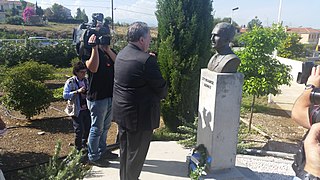
Kyrenia is a city on the northern coast of Cyprus, noted for its historic harbour and castle. It is under the de facto control of Northern Cyprus.

The Ethniki Organosis Kyprion Agoniston was a Greek Cypriot nationalist guerrilla organization that fought a campaign for the end of British rule in Cyprus, and for eventual union with Greece.

Georgios Grivas, also known by his nickname Digenis, was the Cypriot founder and leader of the Greek and Greek Cypriot paramilitary organisations Organization X (1942–1949), EOKA (1955–1959) and EOKA B (1971–1974).
Nikos Sampson was a Cypriot journalist, militant and politician, who was installed as acting President of Cyprus during the 1974 coup.

Evagoras Pallikarides was a Greek-Cypriot poet and revolutionary who was a member of EOKA during the 1955–1959 campaign against British rule in Cyprus. He was arrested on 18 December 1956 when he was caught carrying weaponry on a donkey, to which he confessed in his trial. He was sentenced to death by hanging for firearms possession on 27 February 1957 and was the youngest insurgent to be executed in Cyprus. His death generated widespread controversy due to his young age and the circumstances of his arrest.
Grigoris Pieris Afxentiou was a Greek-Cypriot insurgent leader who led campaigns against the British colonial government as a member of EOKA. He was second-in-command to general Georgios Grivas and used the pseudonym Zidhros (Ζήδρος), the name of a famous 18th-century brigand.
The Battle of Spilia is the name given in Greek Cypriot sources to an engagement of the Cyprus Emergency that took place in the neighbourhood of the Cypriot village of Spilia on either 11 or 12 December 1955. The engagement involved approximately 12 members of Georgios Grivas’s EOKA group and a 40 man detachment of the 45 Commando Royal Marines. In British military sources this is known as part of a wider operation known as ‘Foxhunter’ that was tasked with breaking up the EOKA presence in the Troodos mountains and capturing EOKA leader Georgios Grivas.

Markos Drakos was a Greek Cypriot guerrilla fighter who was killed in the EOKA struggle (1955–1959) against the British. His nom de guerre was Lykourgos. He was born in Nicosia District, on 24 September 1932 and studied accounting. He worked for the Hellenic Mining Company in Cyprus until 1954. When EOKA was formed, Drakos was among the first to join, training others in the use of arms and recruiting members. Drakos was mild-mannered and enthusiastic to learn about military operations, as well as being devoutly religious, and EOKA commander Georgios Grivas "Dighenis" quickly took a liking to him. He saw great potential in Drakos as a leader, and he was quickly promoted to a senior position in EOKA.
Kyriakos Matsis was a Greek Cypriot guerrilla and member of EOKA.

Stylianos Lenas was a member of EOKA, and one of the Cypriots who were wounded in battle against British soldiers.

Michalis Karaolis was a Cypriot public official and revolutionary. Born in the village of Palaichori Oreinis of Pitsilia, Karaolis worked as a government clerk and a member of EOKA. He was the first to be sentenced to death and hanged alongside Andreas Dimitriou on 10 May 1956.

The Cyprus Emergency was a conflict fought in British Cyprus between April 1955 and March 1959.

Frenaros is a village in the Famagusta District of Cyprus, located 4 miles west of Paralimni and 9 miles northwest of Ayia Napa. In 2011, it had a population of 4,298.

The High Bright Sun is a 1964 British action film directed by Ralph Thomas and starring Dirk Bogarde, George Chakiris and Susan Strasberg. It is set in Cyprus during the EOKA uprising against British rule in the 1950s. It was based on a 1962 novel by Ian Stuart Black.
The Cyprus Times, also known as The Times of Cyprus, was an English-language newspaper published in Larnaca, in Cyprus from 1880, following the island becoming a British protectorate in 1878. It was founded by Edward Henry Vizetelly, who also acted as its first editor. Vizetelly had been a war correspondent for the British newspaper The Daily News, and The New York Times.
The 1 April Attacks were a series of attacks across Cyprus in 1955 by the Ethniki Organosis Kyprion Agoniston (EOKA) which led to the start of the Cyprus Emergency. Multiple British locations were attacked after midnight by EOKA members. This attack was accompanied by the distribution of leaflets across Cyprus.
The Battle of the Pine is the name given in Greek Cypriot sources to an attack on a British army vehicle by the EOKA on 24 November 1955. A team of EOKA guerrillas ambushed the vehicles on the road from Kyperounda to Chandria killing one soldier, Sapper Robert Melson.

The Battle of Nicosia Hospital was a military engagement during the Cyprus Emergency. The EOKA planned a raid to rescue Polykarpos Giorkatzis, an EOKA prisoner who had been transferred to hospital. The escape was successful, although the team suffered casualties.
The Raid onLepka took place in April 1957 as part of the Cyprus Emergency. British security forces attacked an EOKA guerrilla group in the mountains and captured seven leading EOKA officers including leader Georghis Demetriou and Mikkis Frillas.
Andreas Zakos, was a Cypriot resistance fighter of EOKA. In December 1955, he was taken prisoner by the British after a failed ambush at Mersinaki and was subsequently sent to the Central Jail of Nicosia where after a few months, was sentenced to death and killed via hanging.









